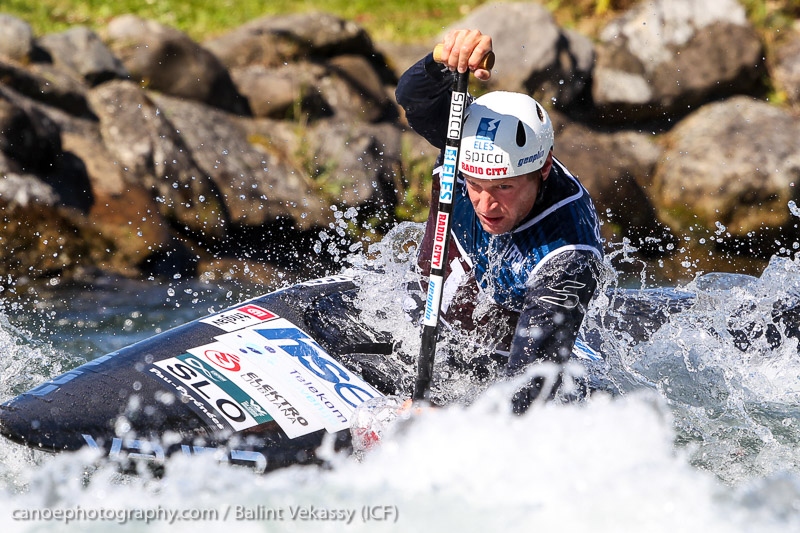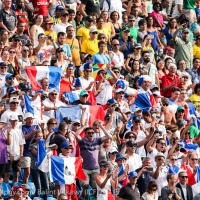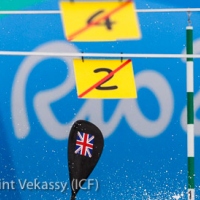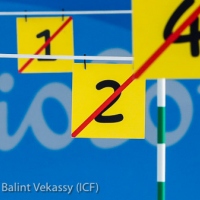Olympic canoe slalom - canoe classes
Today we examine the canoe classes. C1M is an excellent way of analysing canoe slalom. C2M is spectacular to watch as these big boats, with two paddlers, squeeze their way through narrow slalom gates on big whitewater. Here we look at the equipment, pros and cons and some top paddlers past and present.
C1M – Canadian Men’s Single
C1M is pronounced see-one men, meaning a male athlete kneeling in a closed cockpit canoe with a single bladed paddle.
The C1 paddler kneels on pre-formed padded foam blocks inside the cockpit. They then sit back on their heels supported by the foam block and tighten straps across the knees. This prevents them sliding forwards as well as ensuring that, like in a kayak, the C1 becomes an extension of their body.
The International Canoe Federation again has specifications for the C1, which must be 350cm long, 60cm wide and weigh not less than 8kg. The paddler again wears a slightly more rounded spraydeck around their chest & waist which prevents water getting inside the boat.

The C1 gives the paddler much greater height above the boat, which means they have much greater reach with the paddle to create big strokes. They can also reach further through the gate or into a breakout. Because they are kneeling in the boat, all their body weight falls through the centreline of the boat and so it will spin much faster than a kayak. The C1 paddler can also pivot turn in spectacular fashion, sinking the entire back of the boat under the water with one powerful stroke. This is really stunning to watch in high-level competition. Forward paddling is tougher and requires more practice to execute well than in a kayak. C1 is so technically demanding that the key is to start young and spend lots of time on whitewater.
A C1 paddler either paddles naturally on the left (lefty) or on the right of the boat (righty). When they then paddle on the opposite side of the boat they are said to be on the cross-bow. For the C1 paddling in slalom it means that for a lefty C1 it is easier to do a breakout of the left-hand side of the boat than the right. In competition there should be a minimum of six upstream (red and white) gates. The course designer must ensure that a lefty or righty C1 have the same challenge and opportunity. All the breakouts on the left would favour a lefty C1 and their run time would be quicker than a righty C1, doing all the breakouts on a cross-bow.
On the shorter whitewater courses like Deodoro the slalom gate sequences are tighter with less opportunity for forward speed. We see C1 run times very close to those of the K1s. In tight courses the C1 could be quicker, because although they have less forward speed they can turn through breakouts and spins much faster than a kayak. Watching C1 has helped many K1 paddlers and made medal winning C2 crews out of former C1 paddlers.
World Champion from 2011, Denis Gargaud Chanut (FRA) competing in his first Olympics says; “We all know each other very well as there is a lot of people from 86-90 generation we have compete against each other since junior it's going to be tight.”
The World Champions competing in Rio are:
- David Florence (GBR)
- Denis Gargaud Chanut (FRA)
The Olympic medallists competing in Rio are:
- Sideris Tasiadis (GER)
- David Florence (GBR)
Legends of C1M
The most successful Olympic C1M has been triple Olympic Champion Tony Estanguet (FRA) and double Olympic Champion Michal Martikan (SVK). Estanguet & Martikan started competing as juniors in 1994 and then dominated both World Championships and Olympics from 1996 until 2012.
The first strong nations were France, Czechoslovakia, East & West Germany and Switzerland. C1M was then dominated through from 1979 to 1989 by the iconic Jon Lugbill and Davey Hearn from the US.
C2 – Canadian Men’s Doubles
C2M is pronounced see-two, meaning two male athletes kneeling in a two man closed cockpit canoe each with a single-bladed paddle.
The C2M combines great paddle reach, pivot turns combined with impressive forward power. The C2 paddlers also kneel on pre-formed padded foam blocks inside the cockpit, before securing with straps across the knees.
The International Canoe Federation again has specifications for the C2, which must be 410cm long, 75cm wide and weigh not less than 13kg. It is important for the C2 crew to spend considerable time in their boat on whitewater so they have good communication and coordination. This is essential to successfully roll a C2!
One C2 paddler will paddle on the left and one on the right. The two cockpits are not always in line but can be slightly offset towards the left or right of the boat. The front man in the C2 can also paddle on the cross bow meaning at that moment both paddlers have their paddler in the water on the same side.
London silver medallist & 2013 World Champion Richard Hounslow (GBR) explains, “The style of C2 crews is dictated by who is the most aggressive in the boat. On a scale, I would say that Anton/Benzien (GER) lead from the back, Bozic/Taljat (SLO) are very even and therefore look smoother than most crews, and David [Florence] and I lead from the front.”

Slovenian 2014 World Champion, Luka Bozic adds; “I think ours is definitely something different from the others. But it is hard to explain, each one of us has different styles and is trying to do his best on his own way.”
The World Champions competing in Rio are:
- Franz Anton & Jan Benzien (GER)
- Luka Bozic & Saso Taljat (SLO)
- David Florence & Richard Hounslow (GBR)
The Olympic medallists competing in Rio are:
- David Florence & Richard Hounslow (GBR)
- Mikhail Kuznetsov & Dmitry Larionov (RUS)
Legends of C2M
The most successful Olympic C2M have been triple Olympic Champions Pavol & Peter Hochschorner (SVK). They have dominated C2M and are the only athletes to have won four consecutive World Championship titles. They have won the World Cup series 10 times since 1999 and the European Championships 6 times.
International C2M at World Championship and Olympics has been dominated by a select group of nations; France, Switzerland, Germany, USA, Poland, Czech Republic, Slovakia & recently Great Britain.
C1W – Canadian Women’s Single
C1W is not yet an Olympic medal class. The International Canoe Federation (ICF) has now voted to establish gender equality for the Tokyo Olympics in 2000. This will be submitted to the IOC for ratification after these Rio games conclude.
The standard of C1W racing improves every year. Some key national federations particularly Australia and Great Britain were early to embrace C1W when it was first introduced. Interestingly, Jana Dukatova (SVK:K1W) who is racing in Rio was the first C1W World Champion in 2010.
The top C1W are currently triple World Champion Jessica Fox (AUS), Katerina Hoskova (CZE), Nuria Vilarrubla (ESP), Mallory Franklin (GBR) and Kimberley Woods (GBR).
Keep tuning in
Tomorrow’s post will describe the terms used in canoe slalom techniques and terminology.
We welcome your interaction. Remember to use hashtag #ICFslalom across all social media. Please comment through @PlanetCanoe on Twitter





